
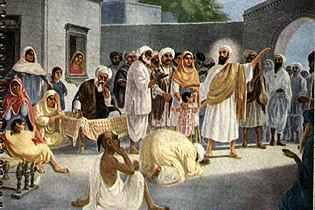
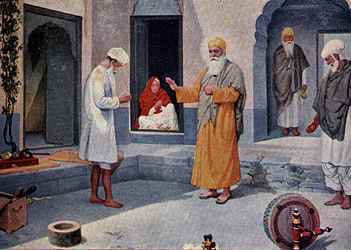
The first person Guru Nanak visited on his 'Udasi' was Bhai Lalo at Emnabad. Guru Ji stayed here for a considerable time and visited him quite a few times later on. Bhai Lalo was a carpenter, who derived his income from hard work and honesty, whilest the king of Emnabad 'Malak Bhago' was a corrupt king. He invited Guru Ji and asked him why he (Guru Ji) did not attend the "Braham Bhoj" (food distribution to all). Guru Ji replied that his income was derived by suppressing the poor, hence his food was infested with the blood of the poor.
This is depicted in the following picture, where Guru Ji in one hand has the 'roti' of Bhai Lalo and on the othert hand the 'puri' of Malak Bhago. He squeezed both and blood trickeled out of Malak Bhago's 'puri' and milk poured out from Bhai Lalo's 'roti' - signifying the essence of Guru Ji's sayings, that 'your living should be honest'.
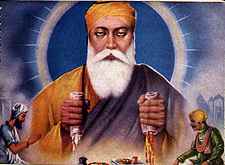
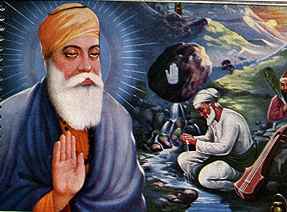
A Pir (Saint) Wali Kandhari, threw a large stone boulder from the top of a mountain, when Mardana had asked him for some water. Guru Ji stopped the stone with His hand and brought the fountain of water to quench Mardana's thirst.
This place is called "Panja Sahib" in Pakistan, and Guru Ji's revered hand print is visible for all to see.
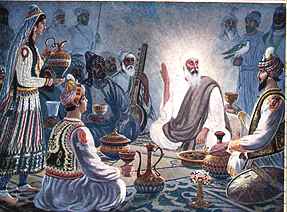
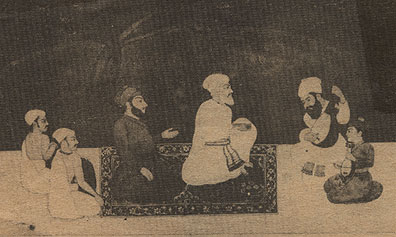
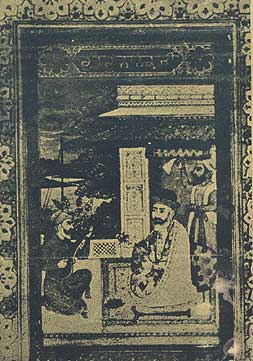
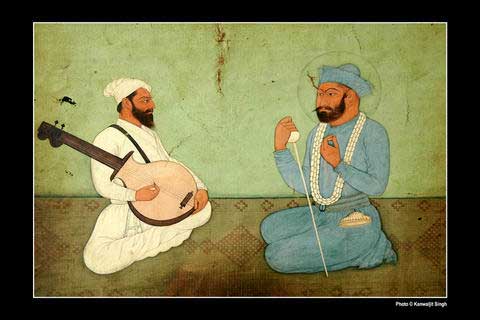
Guru Nanak with Mardana (courtesy Prof. Balwinder Singh)
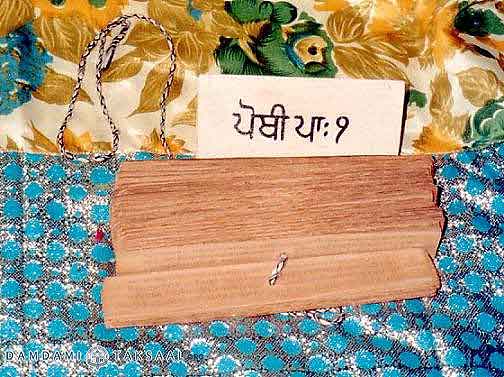
from Raja Kapura & he refused.And also where Guru Ji changed blue dress and wore white clothes. (Courtesy Prof Balwinder Singh)
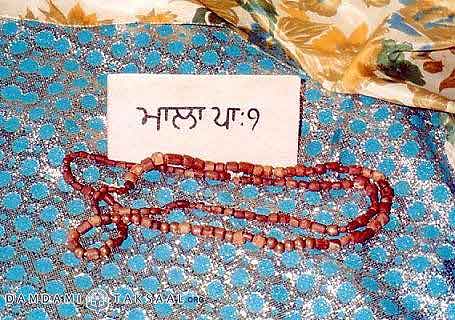
Mala of Guru Nanak at Dhilwan - with Sodhi family (courtesy Prof Balwinder Singh)

Wooden slippers (pauaas) of Guru Nanak (courtesy Prof Balwinder Singh)
=====================================================
WE PRESENT AN ARTICLE BY A MUSLIM WRITER WHICH IS WORTH READING
|
================================================================
Nanak the Great Guru: His Message by Osho
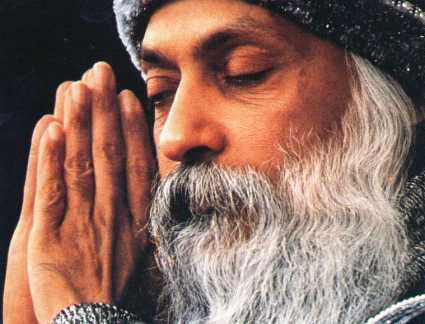
To celebrate the birthday of Nanak the great guru on 17 November, here is Osho’s insight on Ek Omkar Satnam. A simple man, Nanak has overwhelmed humanity with eternal truths in devotion to the ultimate. Osho became one with Nanak and explained the Japuji Sahib in his discourses Ek Omkar Satnam which have become legendary. Even renowned Sikh writers and historians such as Khushwant Singh said that he understood Nanak with a new insight after he read these Osho discourses. The original Hindi discourses have been translated into Gurumukhi and English as most loved of Osho’s books. The English version is called ‘The True Name’. Osho’s original discourses in Hindi and the books with these discourses are available in many major Gurudwaras in Delhi and Amritsar. The former President of India, Giani Zail Singh, launched these audio tapes in Delhi at a grand function and paid a stirring tribute to Osho for making Nanak available to many more people. Here an extract from Osho’s ‘The True Name’.
EK OMKAR SATNAM
HE IS ONE. HE IS OMKAR, THE SUPREME TRUTH.
HE IS THE CREATOR, BEYOND FEAR, BEYOND RANCOR.
HIS IS THE TIMELESS FORM.
NEVER BORN, SELF-CREATING.
HE IS ATTAINED BY THE GURU'S GRACE.
He is one: Ek Omkar Satnam.
In order to be visible to us, things must have many levels, many forms. That's why whenever we see, we see multiplicity. At the seashore we see only the waves, we never see the ocean. The fact is, however, only the ocean is, the waves are only superficial.
But we can see only the superficial because we have only external eyes. To see within requires internal eyes. As the eyes, so the sight. You cannot see deeper than your eyes. With your external eyes you see the waves and think you have seen the ocean. To know the ocean, you must leave the surface and dive below. So in the story Nanak did not remain on the surface, but dived deep into the river. Only then can you know.
Waves alone are not the ocean, and the ocean is much more than a mere collection of waves. The basic fact is that the wave that is now, after a moment no longer will be; nor did it exist a moment ago.
There was a Sufi fakir by the name of Junaid. His son, whom he loved dearly, was killed suddenly in an accident. Junaid went and buried him. His wife was astonished at his behavior. She expected him to go mad with grief at the death of the son he loved so dearly. And here was Junaid acting as if nothing had happened, as if the son had not died! When everyone had left, his wife asked him, "Aren't you sad at all? I was so worried you would break down, you loved him so much."
Junaid replied, "For a moment I was shocked but then I remembered that before, when this son was not born, I already was and I was quite happy. Now when the son is not, what is the reason for sorrow? I became as I was before. In between, the son came and went. When I was not unhappy before his birth, why should I be unhappy now to be without a son? What is the difference? In between was only a dream that is no longer."
What was formed and then destroyed, is now no more than a dream. Everything that comes and goes is a dream. Each wave is but a dream; the ocean is the reality. The waves are many, the ocean only one, but we see it as so many waves. Until we see the unity, the oneness of the ocean, we shall continue wandering.
There is one reality, truth is only one: Ek Omkar Satnam. And, says Nanak, the name of this one, is Omkar. All other names are given by man: Ram, Krishna, Allah. These are all symbols, and all created by man. There is only one name that is not given by man and that is Omkar, and Omkar means the sound of Om..
Why Omkar? -- because when words are lost and the mind becomes void, when the individual is immersed in the ocean, even then the strain of Omkar remains audible within him. It is not a man-made tune but the melody of existence. Omkar is the very being of existence; therefore Om has no meaning. Om is not a word but a resonance that is unique, having no source, no creation by anyone. It is the resonance of the being of existence. It is like a waterfall: you sit beside a waterfall and you hear its song but the sound is created by the water hitting against the rocks. Sit by a river and listen to its sound; it is caused by the river striking against the banks.
We need to go deeper to understand things. Science tries to break down the whole of existence. What it first discovered was energy in the form of electricity, and then charged particles like the electron of which all of existence is made. Electricity is only a form of energy. If we ask a scientist what sound is made of, he will say that it is nothing but waves of electricity, waves of energy. So energy is at the root of everything. The sages say the same thing; they are in agreement with the scientists except for a slight difference of language. Sages have come to know that all existence is created out of sound, and sound is only an expression of energy. Existence, sound, energy -- all are one.
The approach of science is to analyze and break things down, to reach the conclusion. The sage's approach is absolutely different: through synthesis they have discovered the indivisibility of the self.
The wind rises creating a murmur in the branches of the tree, a collision of air against the leaves. When the musician plays a chord on an instrument, the sound is produced by a blow. All sound is produced by an impact, and an impact requires two -- the strings of the instrument and the fingers of the musician. Two are necessary to form any sound.
But God's name is beyond all separateness. His name is the resonance that remains when all dualities have faded and cease to exist. Within this indivisible whole you come across this resonance. When a person reaches the state of samadhi, Omkar resounds within him. He hears it resounding inside him and all around him; all creation seems to be vibrating with it.
He is struck with wonder when it first happens knowing that he is not creating the sound. He is doing nothing and yet this resonance is coming -- from where? Then he realizes that this sound is not created by any impact, any friction; it is the anahat nad, the frictionless sound, the unstruck sound.
Nanak says: Omkar alone is God's name. Nanak refers to name a great deal. Whenever Nanak speaks of His name -- "His name is the path," or "He who remembers his name attains" -- he is referring to Omkar, because Omkar is the only name that is not given to Him by man, but is His very own. None of the names given by man can carry you very far. If they do go some distance towards Him, it is only because of some slight shadow of Omkar within them.
For instance the word ram. When Ram is repeated over and over it begins to transport you a little, since the sound "m" in Ram is also the consonant in Om. Now if you keep repeating it for a long time, you will suddenly discover that the sound of Ram subtly changes into the resonance of Om, because as the repetition begins to quieten the mind, Omkar intrudes and penetrates Ram; Ram gradually fades and Om steps in. It is the experience of all the wise men that no matter with what name they started their journey, at the end it is always Om. As soon as you start to become quiet, Om steps in. Om is always there waiting; it only requires your becoming tranquil.
Says Nanak: "Ek Omkar Satnam."
The word sat needs to be understood. In Sanskrit there are two words: "sat" means beingness, existence, and satya means truth, validity. There is a great difference between the two, though both contain the same original root. Let us see the difference between them.
Satya is the quest of the philosopher. He seeks truth. What is the truth? It lies in the rules whereby two plus two always equals four, and never five or three. So satya is a mathematical formula, a man-made calculation, but it is not sat. It is logical truth but not existential reality.
You dream in the night. Dreams exist. They are sat/reality, but not satya/truth. Dreams are -- or else how would you see them? Their being is there but you cannot say they are true, because in the morning you find they have evaporated into nothingness. So there are happenings in life which are true but not existential. Then there are other occurrences that are existent but are not logically true. All mathematics is true but not existential; it is satya but not sat. Dreams are; they are existential, but they are not true.
God is both. He is sat as well as satya, existence as well as truth. Being both, He can neither be fully attained through science, which probes truth, nor through the arts, which explores existence. Both are incomplete in their search, because they are directed only towards one half of Him.
The quest of religion is entirely different from all other quests. It combines both sat and satya: it is in quest of that which is more authentic and true than any mathematical formula. It is in quest of that which is more existential, more empirical, than any poetic imagery. What religion seeks is both. Looking from any one angle, you will fail; from both directions, then only shall you attain.
So when Nanak says: "Ek Omkar Satnam," both sat and satya are contained in his expression. The name of that supreme existence is as true as a mathematical formula and as real as any work of art; it is as beautiful as a dream and as correct as a scientific formula; it contains the emotions of the heart, and the knowledge and experience of the mind.
Where the mind and the heart meet, religion begins. If the mind overpowers the heart, science is born. If the heart overpowers the head, the realm of art is entered: poetry, music, song, painting, sculpture. But if head and heart are united, you enter into Omkar.
A religious person stands above the greatest scientist; he looks down on the greatest artist, because his search contains the essentials of both. Science and art are dualities; religion is the synthesis.
Nanak says:
"Ek Omkar Satnam.
He is one.
He is Omkar, the supreme truth.
He is the creator..."
-Osho, The True Name, Vol-1, Chapter-1.